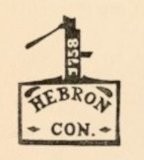
The Hebron Historical Society
Hebron, Connecticut
Enjoy Hebron - It's Here To Stay ™

Known in Washington, D.C. as the “Angel of Mercy”, Josephine Sophia White was born in the Hope Valley section of Hebron in 1814. She was a descendant of Peregrine White, the first white child born in New England. Education was obviously important to the White family as Josephine attended both the Burrows Hill School and Bacon Academy. She married Charles S. Griffing in 1835, and the couple had five daughters, three of whom survived to adulthood.
By 1842, the couple had relocated to Ohio, undoubtedly due to that state’s passion for social reform that matched their own. The couple quickly became involved in abolition efforts. The Griffing’s home was a station on the Underground Railroad. Josephine gave lectures for the Western Anti-Slavery Society and wrote for The Anti-Slavery Bugle. To encourage a larger crowd, and to make her message more palatable, Josephine had her younger sister present a musical program.
During the Civil War, Josephine had moved to Washington where she assisted the newly-freed slaves in learning a new life of self-support. Josephine established connections with people in the federal government as well as many aid organizations. She found food, clothing, and housing for the massive number that arrived in the city. Griffing was even given the use of barracks for housing the destitute. Josephine herself helped find northern homes for more than 7,500 freed people, and often rode with them on the train to get them settled.
Josephine opened Industrial Schools for freedwomen to learn “marketable” skills such as sewing. In Griffing’s own words, "the Industrial School furnishes an opportunity for instruction in social science, and domestic relations, as well as the higher forms of Industry, and a marked change is observable in personal tidiness, good manners, and in the control and government of young children - whom some of the mothers are obliged to bring with them to the Rooms." But it was not enough.
To gain further support for needs of the newly freed slaves, Josephine lobbied members of Congress for more aid. The outgrowth of her efforts was the formation of the Freedmen’s Bureau. She received backing from President Lincoln, Secretary of War Stanton, and many of the conservative congressmen. She also received support of many governors as she traveled about. Similar to many politically-controlled groups, there was major disagreement regarding methods to achieving goals. The Freedmen’s Bureau was discontinued at the end of 1869 although much need still existed.
Following her years of work for the Freedmen, Josephine resumed her efforts towards Suffrage. Josephine wrote to Elizabeth Cady Stanton in 1870 and said “we must lay a corner stone, make Congress understand that the women of the country will be heard.” And she further stated, “O! how I see the want of regulation in national affairs, that can never be accomplished, while Govmt. is administered on the male basis of Representation.” Unfortunately, she only lived a couple more years before dying of Consumption (or T.B. as it is known today).
Upon her death in 1872, Josephine’s body was returned to Hebron, and is buried in the Burrows Hill Cemetery. She was perhaps the bravest crusader ever to be born in our community. Her life’s work is well summarized on the small cemetery monument marking her final location: “A friend to the slave, the poor and oppressed. With unswerving faith in God's eternal justice, her life was given in their service.” To read more about Josephine Griffing, select Hebron & Slavery on our menu. The site includes many documents about Josephine and her work with Abolition, Reconstruction and Women’s Suffrage. Josephine was but one of Hebron’s many special residents.
MaryAnn Foote
Women’s History Month – March 2021